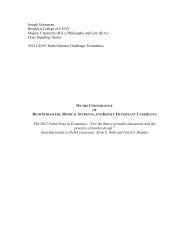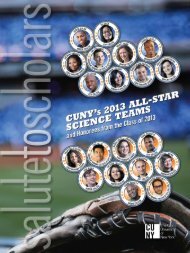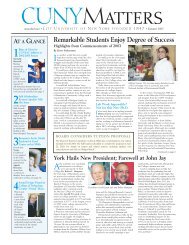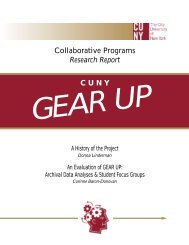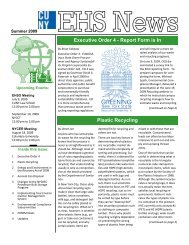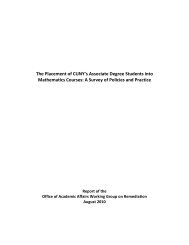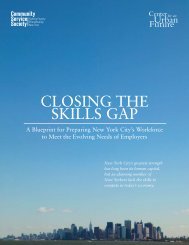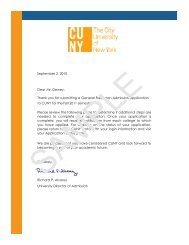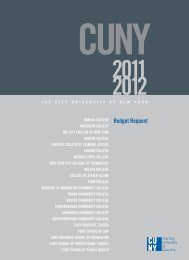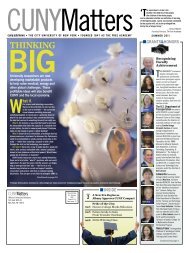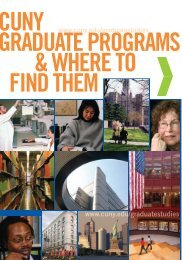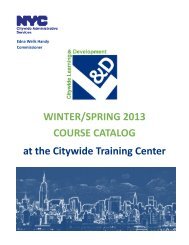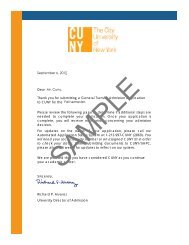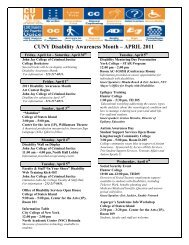CUNY Master Plan 2012-2016
CUNY Master Plan 2012-2016
CUNY Master Plan 2012-2016
Create successful ePaper yourself
Turn your PDF publications into a flip-book with our unique Google optimized e-Paper software.
MISSION PART THREE<br />
health insurance, and other basic needs. These challenges can make it difficult—or impossible—for<br />
<strong>CUNY</strong> students to attend or stay in college. In response, <strong>CUNY</strong> partnered with the SingleStop program<br />
and the Robin Hood Foundation, in 2010, to make students aware of their eligibility for public benefits.<br />
As a result, in the past two years, the University has been able to deliver close to $40 million in public<br />
benefits to students enrolled at our community colleges.<br />
To sustain these important programs, <strong>CUNY</strong> will begin discussions with SingleStop USA and the<br />
Robin Hood Foundation to determine a timeline for institutionalizing staff, services, and benefits technology.<br />
Moreover, during the next four years, <strong>CUNY</strong> will examine whether such services can be replicated<br />
at the comprehensive and senior colleges.<br />
Preparing for College Success<br />
<strong>CUNY</strong> receives 70 percent of its students from the New York City Department of Education (DOE).<br />
The University invests substantial resources in serving these public school students and in serving outof-school<br />
youth. These services focus on preparation for and entry into college and movement through<br />
the first year.<br />
The goals of these pre-college programs are linked closely to the University’s mission: (1) to improve<br />
the academic achievement of high school students so that fewer students require remediation upon entry<br />
to college, and (2) to accelerate credit accumulation and degree completion for students who meet readiness<br />
standards. The work attempts to eliminate obstacles in the transition from high school to college<br />
and takes place through college/public school collaboration and curricular alignment.<br />
Several University initiatives have received national recognition in this regard. College Now, for example,<br />
is an enhanced dual-enrollment program that provides multiple pathways to college readiness<br />
including college-credit courses, preparatory courses, workshops, experiential-based summer programs<br />
and access to campus facilities and cultural offerings. As studies showed that students benefited from<br />
participation in College Now, the program was scaled up. In 2010-2011 it served approximately 20,000<br />
students at all of the undergraduate colleges and over 350 NYC public high schools. In <strong>2012</strong>-<strong>2016</strong> <strong>CUNY</strong><br />
will continue to perform rigorous research and evaluation on the effects of its dual-enrollment programs.<br />
College Now is developing a quasi-experimental study on the effects of the program and is considering<br />
moving toward a random assignment evaluation (an experimental design).<br />
Newer initiatives have borrowed successful practices from College Now. At Home in College (AHC),<br />
for example, is a Robin Hood Foundation funded college transition program that works with students<br />
from DOE high schools and <strong>CUNY</strong> GED programs serving students who are on track to graduate but who<br />
have not met traditional benchmarks of college readiness. The program prepares students for <strong>CUNY</strong>’s<br />
placement exams, provides workshops that help them complete the Free Application for Federal Student<br />
Aid (FAFSA) and the <strong>CUNY</strong> online application, and provides advisement support the summer before<br />
matriculation and during their first year at <strong>CUNY</strong>. Initial outcomes have been positive, including gains in<br />
college enrollment, gains on the <strong>CUNY</strong> Placement Exams (and less need for remedial coursework), and<br />
higher persistence rates into the third semester compared to a similar <strong>CUNY</strong> cohort. AHC is scaling up;<br />
61



